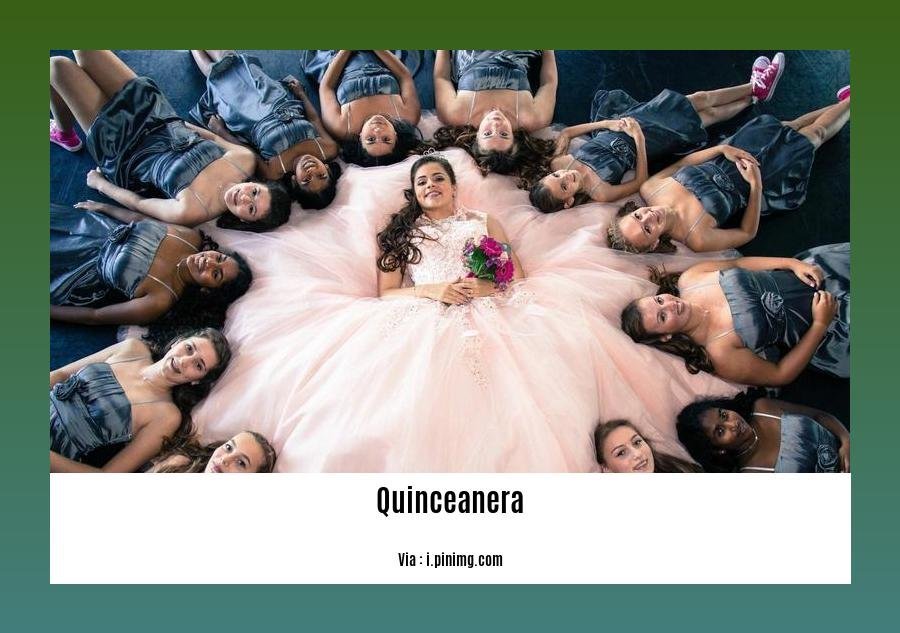Prepare to be mesmerized as we embark on a captivating journey into the world of quinceañeras in our article titled “15 Fascinating Facts About Quinceañeras: Unveiling the Traditions and Cultural Significance.” Delve into the rich history, captivating customs, and profound meaning behind this cherished Latin American tradition. Join us as we uncover the intriguing stories, heartfelt emotions, and vibrant celebrations that make quinceañeras a milestone like no other.
Key Takeaways:
The Quinceañera ceremony, rooted in Aztec and Indigenous traditions, marks a young girl’s transition to adulthood.
In modern Mexico, the Quinceañera blends Aztec and Indigenous customs with Spanish Catholic traditions.
The Quinceañera dress, traditionally a white or pastel ball gown, holds cultural significance.
Dancing forms a significant part of any Quinceañera celebration.
Gifts hold special meaning and symbolize the young woman’s journey to adulthood.
Facts About Quinceanera

Quinceañeras, a cherished tradition with roots in ancient Mexico, are coming-of-age celebrations brimming with history and symbolism. Let’s unravel some intriguing facts about these milestones:
A Journey of Transformation
- Aztec Origins: Quinceañeras trace their lineage to Aztec and Indigenous traditions, honoring a young girl’s transition to womanhood.
- Catholic Influence: In modern Mexico, the celebration blends Aztec customs with Catholic traditions brought by Spanish colonizers.
The Quinceañera Dress
- A Symbol of Purity: The traditional white or pastel ball gown represents the young woman’s purity and innocence.
- Elaborate Designs: The dress often features intricate beading, embroidery, and embellishments, reflecting the significance of the occasion.
Dancing the Night Away
- A Showcase of Grace: Dancing takes center stage at Quinceañeras, with the waltz being a popular choice for the young woman and her father.
- Cultural Rhythms: Traditional Mexican music, such as mariachi, fills the air, creating a lively and festive atmosphere.
Gifts of Meaning
- Symbolic Offerings: Gifts presented to the young woman hold special meanings, representing her transition to adulthood.
- Jewelry and Charms: Necklaces, earrings, and bracelets are common gifts, symbolizing eternal love and protection.
Cultural Diversity
- Embracing Traditions: Quinceañeras are celebrated in various Latin American countries, with each region adding its unique customs.
- A Global Celebration: The celebration has gained popularity worldwide, with families from different cultures incorporating their own traditions.
A Milestone to Remember
- A Lifetime Memory: Quinceañeras are cherished moments, creating lasting memories for the young woman and her family.
- A Stepping Stone: The celebration marks a pivotal moment, symbolizing the young woman’s readiness to embrace adulthood.
Question to Ponder
- How might someone from a different culture be able to understand and appreciate the significance of a Quinceañera?
Analogies and Metaphors
- A Butterfly’s Emergence: Just as a butterfly emerges from its cocoon, the Quinceañera symbolizes the young woman’s transformation into a beautiful and confident young lady.
- A New Chapter: The celebration is like a new chapter in a book, representing the young woman’s journey into adulthood.
Want to explore some fascinating facts about the Russian language? If so, check out this insightful article. Have you ever been curious about the Japanese language and its rich history? If so, you’ll definitely want to read all about it in this comprehensive guide.
**Quinceañera History: Tracing the Roots of a Beloved Tradition**

**The Indigenous Origins of Quinceañeras**
Deep-rooted in the history of ancient Mesoamerica, the quinceañera finds its genesis in the Aztec and Mayan cultures. During this time, girls would undergo initiation ceremonies marking their transition from childhood to adulthood, preparing them for marriage and the responsibilities that came with it. These rites of passage, held to honor and protect young women, were woven into the very fabric of these ancient societies.
**Spanish Influence and the Evolution of the Celebration**
The arrival of Spanish conquistadors in the 16th century brought with it a blending of cultures that would shape the quinceañera into the vibrant celebration we know today. The fusion of Aztec traditions with Catholic customs led to the quinceañera becoming a significant religious event, further symbolizing a young woman’s readiness to enter adulthood.
**A Journey Through the Centuries**
With the passage of time, the quinceañera continued to evolve, reflecting the changing societal norms of each era. The focus shifted from preparing young girls solely for marriage to celebrating their personal growth and achievements, an acknowledgment of their unique capabilities and aspirations.
**A Celebration of Culture and Individuality**
In modern times, the quinceañera has blossomed into a cherished celebration of a young woman’s coming of age. While traditions may vary from family to family, depending on their cultural heritage, the essence of the quinceañera remains—a joyous occasion marking a milestone in a girl’s life and a celebration of her unique cultural identity.
Key Takeaways:
The Quinceañera finds its roots in the pre-Columbian era, originating from the initiation ceremonies of indigenous cultures in ancient Mesoamerica.
During the Spanish colonial era, Catholic customs blended with indigenous traditions, evolving the quinceañera into a significant religious-cultural celebration.
Over time, the focus of the quinceañera shifted from solely preparing young women for marriage to celebrating their personal growth, individuality, and accomplishments.
Today, the quinceañera is a joyous event that varies from family to family, honoring the cultural heritage of the celebrant while celebrating her transition to adulthood and individuality.
Sources:
[1] Encyclopedia Britannica:
[2] The Ultimate Guide to Quinceañeras:
Facts about quinceañera in Spanish
Quinceañeras, a cherished tradition in Latin American culture, mark the transition of young women from childhood to womanhood. These celebrations are steeped in history, customs, and significance, making them a pivotal moment for families and communities. Let’s explore some fascinating facts about quinceañeras in Spanish:
- Orígenes Antiguos:
- Las quinceañeras se originaron en las culturas indígenas de Mesoamérica, donde se celebraba el paso de las jóvenes a la edad adulta.
Estas ceremonias prehispánicas honraban a la diosa Tlazoltéotl, asociada con la fertilidad y el parto.
Raíces Históricas:
Durante la época colonial, la celebración se fusionó con las costumbres españolas, adoptando elementos católicos como la misa y la bendición de la quinceañera.
Celebración Religiosa:
- La ceremonia religiosa es un elemento esencial de la quinceañera.
La joven acude a misa acompañada de sus padres, padrinos y corte de honor, y recibe una bendición especial del sacerdote.
Fiesta Grandiosa:
- La fiesta es el evento social que sigue a la ceremonia religiosa.
Es una gran celebración con comida, música, baile y entretenimiento, a la que asisten familiares, amigos y allegados.
Vestimenta Elegante:
- La quinceañera luce un hermoso vestido, generalmente un vestido de fiesta largo y elaborado.
El vestido suele ser blanco o de colores pasteles, y puede estar adornado con encajes, pedrería o bordados.
Corte de Honor:
- La quinceañera está acompañada por una corte de honor formada por sus damas y chambelanes.
Estos jóvenes asisten a la quinceañera en sus bailes y otros aspectos de la celebración.
Tradiciones Regionales:
- Las tradiciones de las quinceañeras varían según la región y la cultura.
En algunos países, la quinceañera recibe un ramo de flores o un collar especial como símbolo de su nuevo estatus.
Celebración de la Cultura:
- Las quinceañeras son una forma de celebrar y transmitir la cultura latina a las nuevas generaciones.
- La música, la comida, los bailes y los rituales de la celebración reflejan la rica herencia cultural de la región.
Key Takeaways:
- Quinceañeras originated from ancient Mesoamerican indigenous cultures’ coming-of-age ceremonies.
- The celebration evolved during the Spanish colonial era, blending Catholic rituals with indigenous traditions.
- The focus shifted from preparing young women for marriage to celebrating their personal growth, individuality, and accomplishments.
- Modern-day quinceañeras celebrate a young woman’s coming of age and her unique cultural identity.
- Traditions vary from family to family, honoring the cultural heritage of the celebrant.
Sources:
FAQ
Q1: What is the origin of the Quinceañera celebration?
A1: The Quinceañera tradition has roots in ancient Aztec culture, with indigenous initiation ceremonies marking a girl’s passage from childhood to adulthood. These ceremonies continued for centuries, blending with Catholic customs introduced by Spanish colonizers to create the modern-day Quinceañera.
Q2: Why is the number 15 significant in the Quinceañera celebration?
A2: The number 15 holds cultural and religious significance in the Quinceañera tradition. In Aztec culture, 15 was considered a sacred number representing the end of childhood and the transition to adulthood. It also coincides with the Catholic tradition of celebrating a girl’s 15th birthday as the age of accountability and readiness for marriage.
Q3: What are some traditional elements of a Quinceañera celebration?
A3: Traditional elements of a Quinceañera celebration include a special Mass with the celebrant’s parents, godparents, and court of honor. This is followed by a grand party featuring music, dancing, and a special dress for the quinceañera, which is often a ball gown or elaborate traditional attire. Guests offer gifts and blessings to symbolize the young woman’s transition to adulthood.
Q4: How is the Quinceañera celebrated in different Latin American countries?
A4: While sharing common traditions, the Quinceañera celebration varies across Latin American countries. In Mexico, it is known as “fiesta de quince años” or “fiesta de quinceañera,” with a focus on the religious ceremony and elaborate parties. In other countries like Colombia, Ecuador, and Guatemala, the celebration may include traditional dances, music, and cultural elements unique to their respective regions.
Q5: What is the cultural significance of the Quinceañera celebration?
A5: The Quinceañera holds immense cultural significance as a rite of passage for young women in Latin American communities. It symbolizes the transition from childhood to adulthood, emphasizing the importance of family, community, and cultural heritage. The celebration showcases the quinceañera’s readiness to take on new responsibilities and embrace her role as a young woman in society.
- SYBAU See You Baby Meaning: Gen Z Slang Evolves - July 1, 2025
- Unlock Your Inner Youth: Lifestyle Secrets for a Vibrant Life - July 1, 2025
- Decode SYBAU Meaning: Gen Z Slang Explained - July 1, 2025






